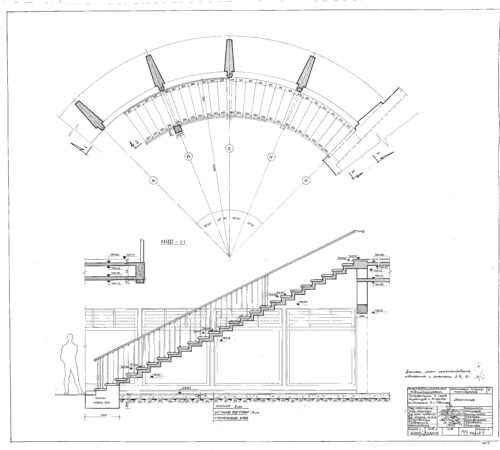Architects Alexandre Jibladze, Madlena Komakhidze “Tbilkalakprojekt” – head of studio Ivane Chkhenkeli, leader of the group Yuri Kasradze
Civil engineer Davit Kajaia
Design 1957-1959 Construction 1959-1960
Status built
Original function planetarium
Condition demolished
Address Mtatsminda Park, Tbilisi
Google Maps
The first planetarium of Tbilisi was built in 1960 on the plateau of Mtatsminda, 726 meters above sea level. According to the project task, the planetarium was to be a cultural-educational facility to increase the popularity of astronomy among the public. It was to include a domed hall, a surrounding corridor, a vestibule and offices. Reinforced concrete was intending as the construction material.
In 1955, the Executive Committee of Tbilisi City Council issued a decree on the design of the city’s cultural and recreational parks and on cultural-mass activities. According to this decree, a planetarium and a dance floor were to be opened in 1957 in the Mtatsminda Cultural and Recreational Park, which at that time was still named after Stalin. The client was the Cultural Department of the Executive Committee of Tbilisi. The planetarium project was to be realized with the “unspent project costs” of 1956. The site of the carousel was chosen as the construction site. A studio of the “TbilQalaqProekti” under the direction of Vano Chkhenkeli, was appointed to work out the project. A letter signed by Chkhenkeli is preserved in the National Archives, in which he “entrusted the elaboration of the project to the architects Jibladze and Komakhidze”. The chief engineer of the project was Davit Kajaia.
The planetarium of Mtatsminda was a circular two-story building with a high dome. On the ground floor there was the round entrance hall with the terrazzo floor and offices. On both sides of the entrance, two symmetrically arranged staircases led up to the auditorium on the upper floor. The parabolic dome rested on supporting pillars distributed on a circle. It had a diameter of 11.20 meters and a height of 12.50 meters. The thickness of the dome shell was not more than 10 centimeters and was probably reinforced with a steel mesh. An interesting expression of spatial imagination is the concept of the inner dome. It was a construction of wooden slats suspended from above by steel cables. The dome of the “artificial sky” – a thin, curved plywood sheet covered with canvas – was attached to this construction. The diameter of this dome was eight meters.
The Mtatsminda planetarium was a small, compact building with nothing superfluous in terms of architecture and construction. It was created at the intersection of two eras of Soviet architecture and reflected its time well.
The technical equipment and the rules of use of the Levitsky and Fedorov “P-2” type educational planetarium were specified in the instructions (1949). The apparatus was operated manually and mechanically. Holes of different sizes were distributed on its surface according to the position of the celestial bodies, which were illuminated by a point of light directed from inside, creating a projection on a spherical textile dome. With this simplified device it was possible to show the movement of the stars of the northern and southern hemispheres and the movement of the sun both by day and night and throughout the year.
Generations of children of that time still remember the planetarium. The magical world began with the floor of the vestibule – here the signs of the zodiac, symbolic images of the planets and constellations were painted on the circle and above, as if the stars were also shining during the day in the boundless sky. In the planetarium we could learn why spring follows winter, that in reality the sun does not “rise and set” but the earth revolves around it, which stars can be seen from South America and much more. The darkened space had a magical attraction in which the role of architecture was crucial. The planetarium was demolished at the end of 1990-ies. (ntch)
Images: Alexandre Jibladze personal archive, National Archives of Georgia, Cronobook – Silva G.Mskhali



















